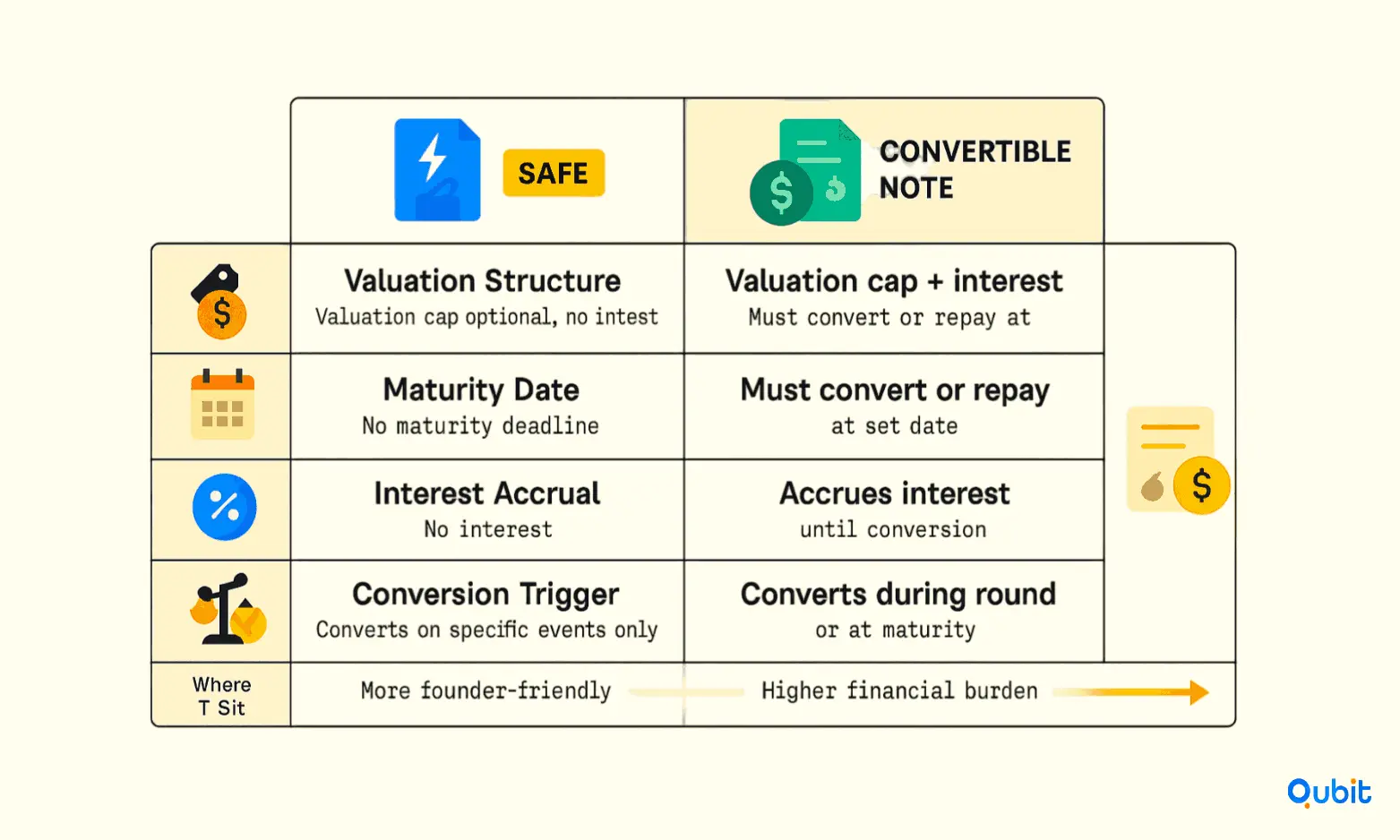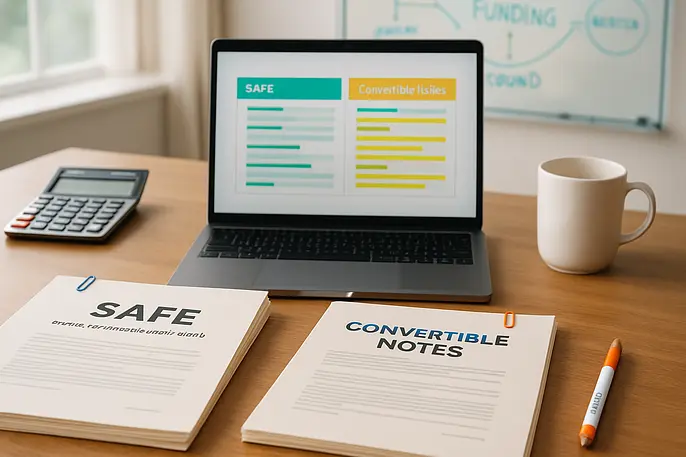Selecting the ideal fundraising instrument can be a pivotal decision for startups and investors alike. SAFE (Simple Agreement for Future Equity) and Convertible Notes are two popular options, each offering distinct advantages and challenges. While SAFE agreements simplify equity conversion, Convertible Notes incorporate debt-like features, adding complexity to the equation. Understanding these differences is essential for making informed choices that align with your financial goals.
This article explores the critical distinctions between SAFE and Convertible Notes, covering valuation, tax implications, usage scenarios, and legal considerations. Whether you're a founder or an investor, this guide will help you navigate the complexities of startup fundraising instruments effectively.
Overview of Convertible Instruments
Convertible instruments play a pivotal role in startup financing. They offer flexible options for early-stage investors and founders alike. These tools, including convertible securities, convertible notes, and SAFE notes, are designed to bridge the gap between equity and debt, providing startups with immediate funding while deferring valuation discussions.
Convertible Securities and Their Structure
Convertible securities are hybrid financial instruments that can transform into equity at a later stage, typically during a funding round or upon achieving specific milestones. This flexibility makes them attractive for startups seeking to avoid complex negotiations early on.
Convertible Notes: Debt with a Twist
Convertible notes function as short-term debt that converts into equity during a future financing event. They often include interest rates and maturity dates, adding a layer of complexity compared to other instruments. While they were once the go-to option for early-stage deals, their popularity has waned in favor of simpler alternatives.
Reflecting their widespread utility, convertible notes reached $48 billion in issuances last year. This scale highlights investor confidence and the instrument's central role in global startup financing.
A notable example, Indigo Capital LP received convertible promissory notes up to $10 million in a registered direct offering. This showcases the significant value and flexibility convertible instruments hold in scaling real investment deals.
SAFE Notes: The Industry Favorite
SAFE notes (Simple Agreement for Future Equity) have emerged as the dominant choice for pre-seed deals, accounting for nearly 90% of transactions. This trend reflects the industry's preference for instruments with lower costs and reduced complexity. As SAFEs do not accrue interest or have maturity dates, they streamline the fundraising process, making them particularly appealing to startups and investors alike.
Understanding the nuances of these instruments is essential for startups aiming to secure funding efficiently while aligning with investor expectations. If timelines are tight, the trade-offs in convertible note vs equity help you choose a clean path without legal sprawl.
SAFE vs Convertible Notes: Key Differences
Choosing between a SAFE and a convertible note isn't just paperwork, it's a decision that impacts your cap table, investor relationships, and future fundraising flexibility. Both instruments let you raise capital without setting a valuation today, but the terms beneath the surface create meaningfully different outcomes.

Valuation Caps and Discount Rates: Who Pays What
Both SAFEs and convertible notes typically include valuation caps, the maximum company valuation at which investor funds convert to equity. This protects early backers: if you raise a seed round at a $10M cap and later close Series A at a $50M valuation, early investors still convert at the lower $10M number, giving them significantly more equity for their capital.
Where these instruments diverge is cost structure. Convertible notes layer on a discount rate (typically 15–25%) and accrue interest over time. Translation: the longer you take to raise your next round, the more expensive that early capital becomes. If you close a note with a 20% discount and 8% annual interest, and it takes you 18 months to raise Series A, investors convert at a discount plus 12% additional interest, effectively increasing their equity stake at your expense.
SAFEs eliminate this compounding cost. No interest accrual. No ticking clock adding to dilution. You raise capital, and the conversion terms stay fixed until the trigger event.
Maturity Dates: Flexibility vs. Forcing Function
Convertible notes come with maturity dates, typically 18 to 24 months. Hit that deadline without raising a priced round, and you're obligated to either repay the principal (rarely realistic for pre-revenue startups) or renegotiate extension terms with noteholders. This creates leverage asymmetry: investors can demand better conversion terms or force uncomfortable conversations when you're least positioned to negotiate.
SAFEs have no maturity dates. The instrument stays on your cap table indefinitely until a conversion trigger—usually a priced equity round, occurs. This removes the repayment pressure but also means early investors remain in limbo longer if your fundraising timeline stretches.
For founders, this is a double-edged sword. No maturity date means no artificial urgency, but it also means no forcing function to close your next round. Some founders appreciate the breathing room; others find that convertible note deadlines create helpful fundraising discipline.
Conversion Triggers: When Does the Money Become Equity?
Convertible notes typically convert in two scenarios: during a qualified financing round (usually defined as raising a minimum amount, like $1M+) or at maturity if no round materializes.
SAFEs convert only during specific trigger events, most commonly a priced equity round, but potentially also during acquisition or dissolution. There's no maturity-based conversion, which again provides flexibility but can leave early investors in convertible limbo if you bootstrap profitability without raising additional rounds.
The nuances of funding alternatives are further clarified by negotiate startup investment terms, where you encounter an investor-focused breakdown of deal-making approaches.
SAFE vs Convertible Notes vs Equity: A Comparison
Understanding the nuances of funding instruments is crucial for startups and investors alike. Convertible notes, equity financing, and SAFE (Simple Agreement for Future Equity) notes each offer distinct advantages and challenges, depending on your goals and timeline.
Convertible Notes: Delayed Valuation Decisions
Convertible notes are debt instruments that convert into equity at a later stage, typically during a future financing round. This approach postpones the need to determine a company’s valuation upfront, making it appealing for early-stage startups. Investors benefit from interest accrual and discounts during conversion, while founders gain flexibility in valuation discussions.
Equity Financing: Immediate Ownership Exchange
Equity financing involves issuing shares in exchange for capital, establishing ownership stakes from the outset. Unlike convertible notes, equity financing requires an immediate valuation of the company. While this provides clarity for both parties, it can be time-consuming and legally complex. For those seeking long-term investors who actively participate in the company’s growth, equity financing is often the preferred route.
SAFE Notes: Simplified Agreements
SAFE notes simplify the fundraising process by eliminating interest accrual and maturity dates. These agreements allow investors to secure future equity without the complexities of traditional convertible notes. SAFEs are particularly popular among startups aiming for quick and straightforward funding rounds.
Each funding option serves unique purposes, and understanding their differences can help you choose the right path for your business. A comparative review of funding instruments becomes more comprehensive with term sheet basics, as it offers you a clear explanation of the components that define investment agreements.
Usage and Best Practices
When considering SAFE vs Convertible Notes, it's important to understand how each aligns with your strategic goals.
Selecting the right funding instrument is a critical decision for startups, and understanding the best practices for fundraising can significantly impact long-term success. Both SAFE notes and convertible notes offer unique advantages, but their effectiveness depends on how well they align with your strategic goals.
- Consider maturity date needs
- Tolerance for legal complexity
- Tax implications for your country
- Dilution risk
- Investor preferences
Cap Table Management During Convertible Rounds
- Record every new SAFE or convertible note issuance immediately, including terms like valuation cap, discount, and investor details.
- Update the cap table after each funding event to reflect potential dilution and changes in ownership percentages accurately.
- Simulate conversion scenarios regularly to anticipate how future rounds and option pool adjustments will affect founder and investor stakes.
- Share updated cap tables with stakeholders to maintain transparency and set realistic expectations about dilution and ownership changes.
- Consult legal or financial advisors to validate cap table calculations and ensure compliance with all agreement terms and local regulations.
Tax Implications
Understanding the tax implications of SAFEs and convertible notes is crucial for both companies and investors. SAFEs (Simple Agreements for Future Equity) generally avoid the complexities associated with interest accrual taxes. Since SAFEs do not accrue interest or classify as debt, they do not trigger taxable events for investors until they convert into equity. This simplicity makes SAFEs an attractive option for startups looking to sidestep ongoing tax liabilities.
Convertible notes, on the other hand, come with distinct tax treatments. These instruments are structured as debt, which means they typically accrue interest over time. For companies, this interest can be deducted as a business expense, offering a potential tax advantage. However, for investors, the accrued interest is treated as ordinary income, which may result in higher tax obligations. Additionally, the conversion of a convertible note into equity can trigger further tax events, depending on the terms of the agreement and the timing of the conversion.
The choice between SAFEs and convertible notes often hinges on these tax considerations. While SAFEs offer simplicity and fewer immediate tax consequences, convertible notes provide interest deductions for companies but may create more complex tax scenarios for investors. Understanding these nuances ensures that both parties can make informed decisions aligned with their financial goals.
Impact on Valuation
Valuation caps, discount rates, and accrued interest are pivotal in shaping startup valuations during the conversion of funding instruments. These elements directly influence the equity split between founders and investors, often determining the extent of founder dilution.
A valuation cap sets a ceiling on the company’s pre-money valuation for convertible instruments, ensuring early investors receive equity at a favorable price. This mechanism protects investors from excessive dilution while potentially increasing the dilution impact on founders. Discount rates, on the other hand, provide investors with a reduced price per share compared to future funding rounds, further affecting the equity distribution. Accrued interest adds another layer of complexity, as the accumulated interest on convertible notes increases the principal amount, leading to a larger equity stake for investors upon conversion.
Ultimately, the interplay of these variables can significantly impact the company’s ownership structure, making it crucial for founders to carefully evaluate the terms of their funding agreements. By doing so, they can mitigate excessive dilution while fostering investor confidence.
Mechanics and Pros/Cons of Instruments
Convertible notes and SAFEs (Simple Agreements for Future Equity) are two popular funding instruments for startups, each with distinct mechanics and implications. Understanding their triggers, timelines, and legal nuances is essential for making informed decisions.
How Convertible Notes Work
Convertible notes are essentially loans that convert into equity during a future financing round. They include terms like maturity dates, interest rates, and valuation caps. The conversion is triggered when the startup raises a qualifying round of funding, allowing the noteholder to receive equity at a discounted rate or a pre-agreed valuation. However, if the startup fails to raise funds before the maturity date, repayment becomes due, which can strain cash flow.
Pros of Convertible Notes:
– Clear structure with defined terms like interest rates and maturity dates.
– Provides early investors with downside protection through repayment clauses.
– Offers flexibility in valuation, deferring it to a later stage.
Cons of Convertible Notes:
– Legal complexity due to debt-like features.
– Risk of financial strain if repayment is required.
– Potential dilution for founders if valuation caps are set too low.
How SAFEs Operate
SAFEs, on the other hand, are agreements that grant investors the right to future equity without the debt-like obligations of convertible notes. They lack maturity dates and interest rates, simplifying the process. Conversion occurs during a future equity round, often at a discount or valuation cap.
Pros of SAFEs:
– Simpler and faster to execute than convertible notes.
– No repayment obligations, reducing financial risk for startups.
– Investor-friendly terms like discounts or caps encourage early participation.
Cons of SAFEs:
– Lack of maturity dates can delay investor returns.
– Less protection for investors compared to convertible notes.
– Potential for founder dilution if valuation caps are not carefully negotiated.
Pre-Conversion Investor Rights: SAFEs vs. Convertible Notes
| Investor Right | SAFE | Convertible Note |
|---|---|---|
| Information access | Limited before conversion | Often granted by note terms |
| Liquidation priority | None until conversion | Debt status provides priority |
| Voting power | No voting rights pre-conversion | No voting rights pre-conversion |
| Repayment rights | No repayment obligation | Repayment possible at maturity |
For deeper insights into the legal frameworks that shape these instruments, explore the legal structures for startup investments. This resource provides a comprehensive overview of how legal considerations influence funding decisions.
How Equity Works
Equity financing is a process that allows businesses to raise capital by issuing shares to investors. This mechanism provides immediate funding without the burden of debt repayment, making it a popular choice for startups and growing companies. When a company issues shares, it essentially offers ownership stakes in exchange for financial investment. These shares can be sold to individuals, venture capitalists, or institutional investors, depending on the business's goals and growth stage.
One of the key advantages of equity financing is the alignment it fosters between founders and investors. Both parties share a vested interest in the company’s success, creating a collaborative dynamic. Investors often bring not only capital but also expertise, networks, and strategic guidance, which can significantly enhance the business's trajectory.
However, equity financing comes with its challenges. Issuing new shares can lead to dilution, reducing the ownership percentage of existing shareholders. This can be a concern for founders who wish to maintain control over their company. Additionally, voting rights granted to shareholders can influence decision-making, potentially leading to conflicts if interests diverge.
Understanding the balance between the benefits and challenges of equity financing is crucial for businesses seeking sustainable growth. By carefully structuring equity deals, companies can attract the right investors while preserving their long-term vision.
Conclusion
The SAFE vs Convertible Notes choice requires a thorough understanding of their unique attributes. While SAFE notes offer simplicity and speed, convertible notes provide flexibility in valuation and repayment terms.
A well-prepared pitch, backed by clear data and insights, can significantly enhance your fundraising efforts. By understanding the nuances of these instruments, founders can make informed decisions that resonate with investors and support long-term growth.
If you’re ready to streamline your fundraising journey, we at Qubit Capital can help with our Fundraising Assistance services. Contact us to get started.
Key takeaways
- SAFE notes and convertible notes each offer distinct benefits and drawbacks in startup fundraising.
- Convertible notes include features like interest accrual, maturity dates, and conversion triggers, adding investor protections.
- SAFEs simplify the fundraising process by eliminating debt characteristics but may result in higher dilution.
- Understanding tax implications and valuation mechanisms is crucial to making an informed choice.
- Real-world case studies underscore the practical impact of these instruments on fundraising strategy.
Frequently asked Questions
What are the tax implications of SAFE vs Convertible Notes?
SAFE notes usually do not trigger tax events until conversion, while convertible notes accrue interest and may have tax liabilities due to interest payments.






